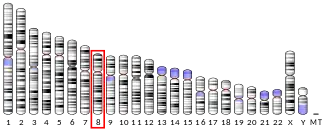| PVT1 | |||||||||||||||||||||||||||||||||||||||||||||||||||
|---|---|---|---|---|---|---|---|---|---|---|---|---|---|---|---|---|---|---|---|---|---|---|---|---|---|---|---|---|---|---|---|---|---|---|---|---|---|---|---|---|---|---|---|---|---|---|---|---|---|---|---|
| Identifiers | |||||||||||||||||||||||||||||||||||||||||||||||||||
| Aliases | PVT1, LINC00079, NCRNA00079, onco-lncRNA-100, Pvt1 oncogene (non-protein coding), MYC, MIR1204HG, Pvt1 oncogene, PVT1 long-non-coding RNA, human | ||||||||||||||||||||||||||||||||||||||||||||||||||
| External IDs | OMIM: 165140 GeneCards: PVT1 | ||||||||||||||||||||||||||||||||||||||||||||||||||
| |||||||||||||||||||||||||||||||||||||||||||||||||||
| |||||||||||||||||||||||||||||||||||||||||||||||||||
| Wikidata | |||||||||||||||||||||||||||||||||||||||||||||||||||
| |||||||||||||||||||||||||||||||||||||||||||||||||||
Pvt1 oncogene (non-protein coding), also known as PVT1 or Plasmacytoma Variant Translocation 1 is a long non-coding RNA gene.[3] In mice, this gene was identified as a breakpoint site in chromosome 6;15 translocations. These translocations are associated with murine plasmacytomas.[4] The equivalent translocation in humans is t(2;8), which is associated with a rare variant of Burkitt's lymphoma.[5] In rats, this breakpoint was shown to be a common site of proviral integration in retrovirally induced T lymphomas.[6] Transcription of PVT1 is regulated by Myc.[7]
Overexpression of PVT1 could lead to tumorigenesis in three ways. Rearrangements of DNA through the fusion of PVT1 and Oncogene tumor suppressor could lead to the dysregulation of oncogene or tumor suppressor genes, eventually leading to tumorigenesis. Next, expression of the PVT1-encoded miRNAs can downregulate tumor suppressor genes, causing tumorigenesis. Finally, increase in the interaction of MYC with PVT1 can lead to tumorigenesis.[8]
Overexpression of PVT1 located at 8q24.21 region of the chromosome is associated with many cancers in human[8] through dysregulation of certain different genes in different cancers. For instance, the overexpression of PVT1 in prostate Cancer downregulates the miR-146a gene that leads to a decrease of miR-146a levels in a cell, through the methylation of CpG island on its promoter region, promoting the suppression of the cancer cell apoptosis.[9] Furthermore, activity of lncPVT1 and its associated microRNAs has been shown to influence chemotherapy resistance in multiple cancers by epigenetic regulation or direct repression of other non-coding transcripts.[10]
References
- 1 2 3 GRCh38: Ensembl release 89: ENSG00000249859 - Ensembl, May 2017
- ↑ "Human PubMed Reference:". National Center for Biotechnology Information, U.S. National Library of Medicine.
- ↑ "Entrez Gene: PVT1 Pvt1 oncogene homolog, MYC activator (mouse)".
- ↑ Cory S, Graham M, Webb E, Corcoran L, Adams JM (March 1985). "Variant (6;15) translocations in murine plasmacytomas involve a chromosome 15 locus at least 72 kb from the c-myc oncogene". The EMBO Journal. 4 (3): 675–681. doi:10.1002/j.1460-2075.1985.tb03682.x. PMC 554241. PMID 3924592.
- ↑ Graham M, Adams JM (November 1986). "Chromosome 8 breakpoint far 3′ of the c-myc oncogene in a Burkitt's lymphoma 2;8 variant translocation is equivalent to the murine pvt-1 locus". The EMBO Journal. 5 (11): 2845–2851. doi:10.1002/j.1460-2075.1986.tb04578.x. PMC 1167233. PMID 3024964.
- ↑ Villeneuve L, Rassart E, Jolicoeur P, Graham M, Adams JM (May 1986). "Proviral integration site Mis-1 in rat thymomas corresponds to the pvt-1 translocation breakpoint in murine plasmacytomas". Molecular and Cellular Biology. 6 (5): 1834–1837. doi:10.1128/MCB.6.5.1834. PMC 367714. PMID 3785181.
- ↑ Carramusa L, Contino F, Ferro A, Minafra L, Perconti G, Giallongo A, Feo S (November 2007). "The PVT-1 oncogene is a MYC protein target that is overexpressed in transformed cells". Journal of Cellular Physiology. 213 (2): 511–518. doi:10.1002/jcp.21133. PMID 17503467.
- 1 2 Cui M, You L, Ren X, Zhao W, Liao Q, Zhao Y (February 2016). "Long non-coding RNA PVT1 and cancer". Biochemical and Biophysical Research Communications. 471 (1): 10–14. doi:10.1016/j.bbrc.2015.12.101. PMID 26850852.
- ↑ Liu HT, Fang L, Cheng YX, Sun Q (December 2016). "LncRNA PVT1 regulates prostate cancer cell growth by inducing the methylation of miR-146a". Cancer Medicine. 5 (12): 3512–3519. doi:10.1002/cam4.900. PMC 5224852. PMID 27794184.
- ↑ Ogunwobi OO, Kumar A (August 2019). "Chemoresistance Mediated by ceRNA Networks Associated With the PVT1 Locus". Frontiers in Oncology. 9 (1): 834. doi:10.3389/fonc.2019.00834. PMC 6718704. PMID 31508377.
Further reading
- Guan Y, Kuo WL, Stilwell JL, Takano H, Lapuk AV, Fridlyand J, Mao JH, Yu M, Miller MA, Santos JL, Kalloger SE, Carlson JW, Ginzinger DG, Celniker SE, Mills GB, Huntsman DG, Gray JW (October 2007). "Amplification of PVT1 contributes to the pathophysiology of ovarian and breast cancer". Clinical Cancer Research. 13 (19): 5745–5755. doi:10.1158/1078-0432.CCR-06-2882. PMID 17908964.
- Millis MP, Bowen D, Kingsley C, Watanabe RM, Wolford JK (December 2007). "Variants in the plasmacytoma variant translocation gene (PVT1) are associated with end-stage renal disease attributed to type 1 diabetes". Diabetes. 56 (12): 3027–3032. doi:10.2337/db07-0675. PMID 17881614.
- Carramusa L, Contino F, Ferro A, Minafra L, Perconti G, Giallongo A, Feo S (November 2007). "The PVT-1 oncogene is a Myc protein target that is overexpressed in transformed cells". Journal of Cellular Physiology. 213 (2): 511–518. doi:10.1002/jcp.21133. PMID 17503467.
- Hanson RL, Craig DW, Millis MP, Yeatts KA, Kobes S, Pearson JV, Lee AM, Knowler WC, Nelson RG, Wolford JK (April 2007). "Identification of PVT1 as a candidate gene for end-stage renal disease in type 2 diabetes using a pooling-based genome-wide single nucleotide polymorphism association study". Diabetes. 56 (4): 975–983. doi:10.2337/db06-1072. PMID 17395743.
- Oh JH, Yang JO, Hahn Y, Kim MR, Byun SS, Jeon YJ, Kim JM, Song KS, Noh SM, Kim S, Yoo HS, Kim YS, Kim NS (December 2005). "Transcriptome analysis of human gastric cancer". Mammalian Genome. 16 (12): 942–954. doi:10.1007/s00335-005-0075-2. PMID 16341674. S2CID 69278.
- Graham M, Adams JM (November 1986). "Chromosome 8 breakpoint far 3′ of the c-myc oncogene in a Burkitt's lymphoma 2;8 variant translocation is equivalent to the murine pvt-1 locus". The EMBO Journal. 5 (11): 2845–2851. doi:10.1002/j.1460-2075.1986.tb04578.x. PMC 1167233. PMID 3024964.
- Shtivelman E, Bishop JM (March 1989). "The PVT gene frequently amplifies with MYC in tumor cells". Molecular and Cellular Biology. 9 (3): 1148–1154. doi:10.1128/MCB.9.3.1148. PMC 362705. PMID 2725491.
- Shtivelman E, Henglein B, Groitl P, Lipp M, Bishop JM (May 1989). "Identification of a human transcription unit affected by the variant chromosomal translocations 2;8 and 8;22 of Burkitt lymphoma". Proceedings of the National Academy of Sciences of the United States of America. 86 (9): 3257–3260. Bibcode:1989PNAS...86.3257S. doi:10.1073/pnas.86.9.3257. PMC 287109. PMID 2470097.
- Shtivelman E, Bishop JM (April 1990). "Effects of translocations on transcription from PVT". Molecular and Cellular Biology. 10 (4): 1835–1839. doi:10.1128/MCB.10.4.1835. PMC 362296. PMID 2181290.

